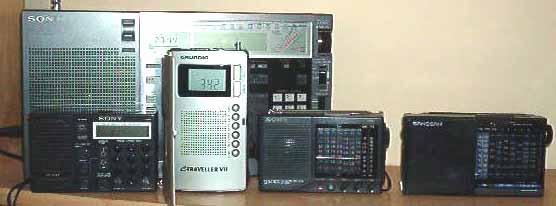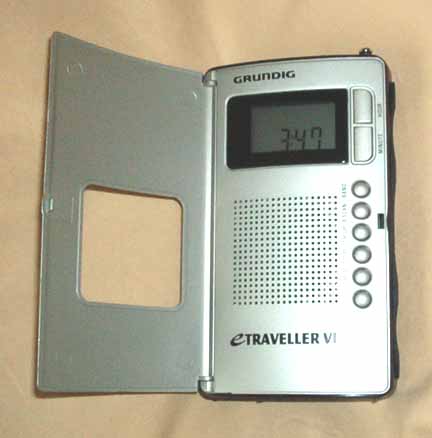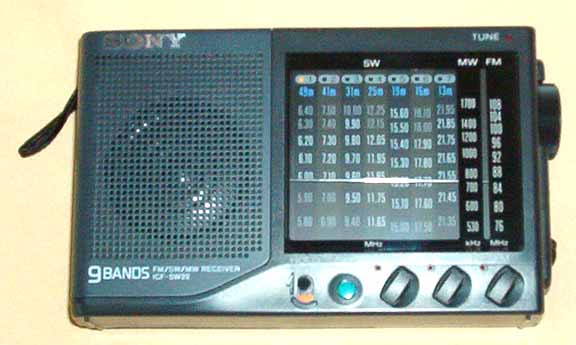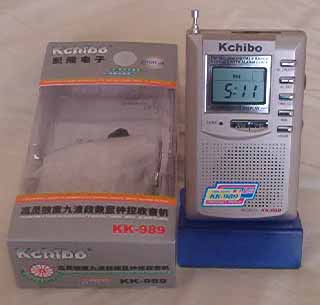Review: Grundig eTraveller VII & Sony ICF-SW22
Small Shortwave Radios for Travelling

From left to right: Sony ICF-SW1S, Grundig eTraveller VII, Sony ICF-SW22 and Sangean MS101 (Sony ICF-2010 in back)

Text and photos by Art Simon
I travel out of the country on occasion, and I've always enjoyed having a shortwave radio along. It's nice to have a source of English language news and its relaxing to listen to after a day of sightseeing. The problem for me has always been finding the right radio. After my Sony SW1S died, I searched for a replacement. The Sony ICF-SW100S is the obvious choice as its the direct replacement for the SW1S, but at well over $300 it's on the pricey side. I tried two models nearer the $100 mark, the Grundig eTraveller VII and the Sony ICF-SW22.
I've owned a few shortwave radios. If you are a radiohead like myself you might be interested in some of the other radios for comparison. My first radio was a Magnavox D2935, an excellent radio that served me well for nearly 10 years. At one point I bought a Grundig Satellit 500 to replace it. Even at twice the price of the D2935, the Grundig's reception was no better and if anything the sound quality of the Magnavox was superior. I returned the Satellit. Later, when a local "Good Guys" store had the Grundig YB-400PE on sale, I brought one of those home and again found the Magnavox superior.
The Magnavox was too big for traveling. My first travel radio was a Sangean MS-101. The Sangean was a great radio in several respects: size, quality, customer service (Sangean sent me a new one when my first was damaged in the San Francisco earthquake of 1989!) and ease of use. It's shortwave reception left much to be desired however. It was a single conversion design and even the strongest singles were accompanied by whistles and whines. I had wanted a Sony ICF-SW1S but couldn't see myself spending the $350 they were selling for. When I found a used SW1S at Universal Radio for $150, I snapped it up. It served me well for more than 5 years. When it died, I was still able to sell it on ebay for nearly half what I paid for it! When the Magnavox died, I bought a Sony ICF-2010. If the Magnavox was excellent the ICF-2010 was superb. It's the best shortwave radio I've used and it's a shame that Sony has just recently discontinued it. My first replacement for the SW1S was the Grundig YB-300PE which despite its single conversion design was an excellent radio except for one infuriating aspect: the light button was on the front of the radio and couldn't be disabled. Every time I travelled with it, I arrived to find it dead. I had to replace the batteries, and even worse, reprogram the clock and the radio presets. I sold it on ebay and looked for another good traveling radio. I searched the internet for information for a replacement, and the information I found was less than satisfatory. I considered the Sangean ATS-606AP until I discovered that like the Grundig YB-300, it had a light button that wasn't disabled by the power lock. Don't these radio designers ever travel with a radio in their suitcase? There seemed to be two promising travel radios in the $100 range that were about the same size as my old SW1S: the Grundig eTraveller VII and the Sony ICF-SW22 and I ended up trying them both at my home in San Francisco.
I bought my eTraveller on ebay. It was a refurbished model and I paid a very reasonable $59.95 for it from Durham Radio in Ontario Canda. (Bargain hunters should keep an eye out for the Tecsun PL707A which is apparently the same radio and can sell for $35). The eTraveller came with a one year warranty. Shipping was $12.95 and the radio arrived in a very speedy three days. The radio comes with a generous amount of accessories: a stand, an AC adaptor, stereo earbuds and a case. Surprisingly, the radio doesn't come with an external wire antenna like the YB-300 does. There is no jack for an external antenna either. This may be by design, as I found little improvement when I clipped a wind up shortwave antenna to the Grundig's antenna.
The first thing that struck me about the Grundig eTraveller was that the hinged front cover would protect the power button from being pressed on while the radio was in your suitcase (a problem that plagued my previous Grundig YB-300 where the light button couldn't be disabled). When I received the radio I was shocked to find the power button wasn't on the front of the radio behind the cover, but on the top! Unlike the Sony, there is no power lock to keep it from being accidentally turned on. However, there is a "Standby" feature where you must press the power button twice to turn the radio on. While this arrangement is adequate, it's hard to figure what the designers were thinking. I'm not sure how they intended you to use the radio either, as it doesn't sit very well without the stand. The tall design with the non-folding antenna means its a bit tipsy. It sits quite securely on the included stand though.

Perfomance is okay, but not great. It's not as sensitive as my old SW1S or even the Grundig YB-300. For listening on the west coast here in San Francisco, it really isn't adequate. For travel in stronger signal areas like Europe, it would probably be fine. On the plus side, I don't notice nearly as much interference on the Grundig as I do on the Sony.
Worringly, it's reset itself twice while I've been using it. I removed the batteries and cleaned the contacts, and it hasn't been a problem since, but I'm glad I still have 9 months to go on the warranty. On the plus side, it's a dual conversion design, so it's not plagued by the whistles that the YB-300 was. It lacks the direct frequency of the YB-300 as well, tuning is by two UP and DOWN buttons. There is a stereo headphone jack allowing stereo FM reception with headphones. There are ten presets for shortwave. Since there is no facility to change bands, it's a good idea to set the presets to stations in different bands.
Several posts on the internet mentioned finding it on sale in Japan for as little as $70, but I ended up paying $130 with shipping for mine from audiocubes. It was a bit of a gamble as audiocubes doesn't take returns (except for defective merchandise). I'm unclear on how the warranty works--I'd probably have to return the radio to Sony in Japan. On the plus side, even though it is a Japanese market radio, the manual includes instructions in English. I found the service of audiocubes faultless, as the radio arrived in less than a week from Japan (on a Sunday no less!) by international express mail. The radio comes with a carry case and a small wind up antenna with a metal clip to attach to the radio's antenna.
For traveling the size can't be beat, it's smaller than the Grundig (and ever so slightly smaller than the SW1S and MS101 as well). It has a power lock, and even if it were to lose power, it's not the same inconvienance as losing power on a digital radio. Of course, the downside is no digital memory. Finding stations is more difficult, though the analog display is reasonably accurate. I find bandscanning easier with an analog radio. It takes seconds to scan through a band on the Sony. The Grundig is significantly slower and fussier. The Sony's earphone jack is mono (stereo heaphones will only play through one speaker).

The reception quality isn't as good as my old SW1S, but it's marginally better than the Grundig. The BBC is more listenable on the Sony than the Grundig, at least here in San Francisco in the evening on 5975 and in the morning on 9740. The sound is more mellow, some might say more muffled. There is a two position "news/music" tone button. While generally the radio sounds better than the eTraveller, it is also more subject to intereference. At my apartment I get a large amount in the 9 Mhz range that sounds like it may be from a local TV station. The eTraveller is unaffected.
Attaching the wind up antenna improves reception (surprisingly, if I attach it to the Grundig it doesn't seem to make much difference). There is a significant amount of hiss, and if you aren't use to SW radio you may find it objectionable to listen to. I suspect in strong signals areas like Europe it would be great.
A review of the Kaide KK-9702, a single conversion Chinese digital radio got me thinking. Maybe I'd overlooked some cheaper alternatives. There is a plethora of small, cheap, single conversion Chinese shortwave radios currently available. The Grundig Mini World 100PE and the very similar Tecsun R-818 are commonly seen on ebay for around $20. They are as small as any SW radio that's available. The Passport to World Band radio has given them an unfavorable review, but they are hard to ignore at that price. Less common, but more intriguing is the Tecsun PL737. It appears to be a smaller version of the Grundig YB300 and can also be found occasionally for as little as $20. An ebay auction for the Kaide KK-9702 and Kchibo KK-989 got the better of me, and I ended up with both. Asking prices were $15.99 and $18.99 respectively, and the seller offered discounts on shipping if you bought both.

The Kaide KK-9702 arrived with an instruction manual entirely in Chinese. Luckily, operation is pretty simple. As soon as I had installed the two AA batteries, I had no trouble operating the radio. While, there is a digital display, it's fundamentally an analaog radio with a digital frequency readout. There are no memories or scan tuning. There is a 12 hour clock and alarm. First impressions were very positive. I was able to hear Radio Netherlands on 9850 at 4 pm in the afternoon (here in San Francisco) with no problems. The Sony ICF-SW22 has some bad interference at my location on that band, an was unable to read the station at all. The eTraveller could get it, but it was a bit weaker. Tuning the dial a bit more, WWV on 15000khz and 10000khz as well as Catholic International were all as stong or stronger on the Kaide than the Grundig or Sony. The "High Sensitivity" logo on the box seemed to have some merit. Later in the evening around 7:45pm though, the weakness of the Kaide became apparent. It couldn't receive the BBC on 5975khz, even with the Sony's wind up antenna clipped to the antenna. It fact it was virtually dead in the 5Khz range during the prime evening reception hours. The Shortwave frequency coverage is good, covering the all important 9410Mhz of the BBC that is so convienant for travelling in Europe. There is no dial light, a good thing for a travel radio in my opinion, since I've had a bad experience with the travel light on the Grundig YB-300PE draining the batteries while in my suitcase.

FM reception was good, though the orientation of the radio and the antenna had a huge impact on reception qualtiy. FM is mono to headphones, but the jack accepts stereo headphones without any difficulty (the Sony needs a stereo to mono adapter). Construction quality seems fine for the money, the tilt antenna and flip out stand on the back allow the radio to be securely placed on a table--a big improvement on the Grundig. Still, the quality of the plastic has a noticeably cheaper feel than the Sony or Grundig. There is a power jack on the side (3 volt tip negative) on the side. No adapter or case is included.

The Kchibo KK-989 is very small, smaller even than the Sony ICF SW-22. Operation and reception are similar to the Kaide KK-9702. Unlike all the other radios in this class, the KK-989 takes three AAA batteries, rather than two AAs. While it may be a tad bit more sensitive in the 5Khz range, the big broadcasters like the BBC and Radio Netherlands were pretty much unintelligable even in the prime listening hours. The tuning knob is rediculously sensitive, making tuning difficult. Compounding the difficulty is the fact that the radio shifts frequency 5 or 10 Khz when you take your hand off the tuning dial! It comes with a nice case, stand and earphones, and makes a pretty impressive package for under $20.
I think these the Sony ICF-SW22 and Grundig eTraveller VII represent the best choice for a lightweight travel radio in the $100 range. The Kaide and Kchibo were fun to play with, but don't offer the performance or dependibility of the more expensive radios. The Grundig is a better value than the Sony, but for my money the Sony is the better radio. While the Grundig has more features, the Sony has better performance for the stations I listen to. I found it satisfactory for listening to the BBC, Radio Netherlands and Radio Havana Cuba here in San Francisco in the evening. While the eTraveller has no problem with Radio Netherlands, reception is barely audible for the BBC and Radio Havana Cuba. The Sony's edge in performance probably isn't worth twice the price of the Grundig though, at least not if you will be traveling to strong signal areas. For someone who uses the radio at home, the included power supply and stand of the Grundig are a welcome bonus. The Sony is more thoughtfully designed, where as the Grundig's lack of protection for the power button is inexcusable on a digital travel portable. The Sony also appears to have better build quality as well. The Sony is certainly simpler and will probably have a longer life. My recommendation would be to buy the Sony, especially if you were traveling in Asia and found it for less than $100. Keep in mind, that if you can spring for it, the Sony SW-100S would put either of these two radios to shame.
Back to my homepage.